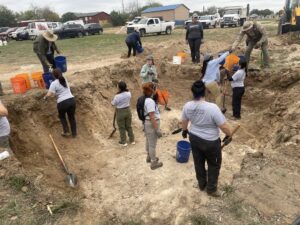By Priscilla Lugo
The changes in federal and state immigration policy over the past decade have caused a shift in migration paths pushing people to take more dangerous routes. The same deterrence strategies that have pushed migrants through the Arizona desert have caused migrants to take the perilous journey through South Texas ranches.
In Texas, experts are estimating that there have been 2,700 migrants who drowned in the Rio Grande between 1997 and 2022. According to CBP’s own reporting, FY 2022, the last full year CBP has data for, was the deadliest in recent history with 895 reported deaths. Neither of these numbers account for the thousands of undercounted deaths of those who die attempting to traverse South Texas ranches. The reason why the number is unknown aside from the unknown deaths, is because there is no state, federal, or international agency in charge of tracking these deaths. Instead, each Texas county has their own mechanism for counting and does not report the deaths to any agency.
I saw this practice firsthand when in December 2023, I went to a mass grave site in Carrizo Spring, TX where Dr. Kate Spradley was working with her students as a part of Operation ID to collect the remains of migrants who died in Dimmit County and attempt to identify them. What I saw in my time there was shocking: a dozen or so graves with crosses made from PVC pipes all named John Doe. This was on the same day when I saw a mother and small child nearly drown in the Rio Grande as the Texas National Guard watched them from 5 feet away.

This is the reality for migrants attempting to travel through Texas into the United States, and the one documentarians Lisa Molomot and Jeffrey Bemiss captured in their film: Missing in Brooks County. On April 17th, I had the pleasure not only to view the film but participate in two panel discussions. The first panel was held at the Texas State Capitol with Dr. Kate Spradley, Eddie Canales, and State Representative Vicki Goodwin where we discussed ways the State can support the crucial work of recovering and identifying the remains of dead migrants. The second panel was later that evening at the LBJ School of Public Affairs with LBJ students studying migrant deaths, along with Lisa, Jeff, and Eddie to talk about the making of the film and the policies that cause these deaths.
The panels happened the same week that the Washington Post published their article, “‘Where do we put the bodies?’” that covers the large increase of migrant deaths in Eagle Pass – the new hotspot for Texas’s Operation Lone Star. The Rio Grande has been transformed in Eagle Pass. What was once a community space for fishing, kayaking, and picnics is now a militarized zone where the riverbed is lined with concertina wire and where Texas National Guard and Texas Department of Public Safety officers bar entry and use of the river for recreational purposes. Their presence and refusal to let migrants who have stepped foot onto Texas land to ask for asylum is a contributing factor into why migrants are attempting to cross the Rio Grande in deeper and more dangerous waters.
On the panel in the morning, Dr. Spradley mentioned that she and her team went to Eagle Pass to pick up some of the bodies of migrants who had drowned that were being kept in the overcrowded trailer freezer referenced in the Washington Post article. She said most of the bodies her team recovered had identification documents but were about to be buried without attempts to identify the bodies, contact their loved ones, or their countries’ consulates. This is the reality of the crisis that local governments are facing—too overwhelmed and not provided enough resources by the state or federal government to provide people with basic human dignity. These are the horrific consequences that South Texans who are working on the front lines deal with as they recover the bodies of those who have either drowned in the Rio Grande or succumbed to dehydration or exposure on a South Texas ranch.
Despite the dire state of things, there is hope and short- and long-term policy solutions. Right now, those tracking migrants’ deaths are researchers at universities like Dr. Kate Spradley and Stephanie Leutertand rely on fragmented records from different counties to best track the deaths. The more immediate policy solutions for this could include creating a state agency or department charged with tracking migrant deaths in Texas. To aid efforts in identifying migrants and repatriating them back to their loved ones, Texas could re-grant funds from border security initiatives to counties to have the resources needed to test DNA.
And finally, for a more expansive approach to end the unnecessary deaths that are occurring, the federal government could create safer pathways by expanding work visas and increasing capacity for Customs officials to process asylum seekers and migrants requesting entry into the country. Doing so would allow migrants to present themselves at ports of entry in an orderly and safe fashion and avoid the perilous journey either through the river or through ranches. These are not only humane immigration policy reforms, but ones that most people agree would help secure our border by reducing the number of those entering the country without authorization between ports of entry.

